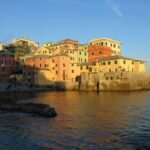Are you ready to be swept away by the enchanting charm of Rome? With its rich history, stunning architecture, and captivating art, Rome is a city that truly captures the hearts of all who visit. From the ancient wonders of the Colosseum to the artistic masterpieces in Vatican City, there’s no shortage of beauty to capture on video.
The allure of Rome goes beyond its iconic landmarks and extends to the vibrant neighborhoods, delicious cuisine, and thriving art scene. As you immerse yourself in the city’s culture, you’ll find endless opportunities to capture moments of magic on film. Whether it’s a bustling food market or a serene street corner, Rome offers countless visual delights for travel videographers.
In this article, we’ll dive into the various facets of Rome’s charm, from exploring its landmarks to savoring its culinary delights. We’ll also provide tips for filming a travel video in Rome and offer insights into venturing beyond the city for unforgettable day trips. So grab your camera and get ready to embark on a visual journey through one of the most timeless and captivating cities in the world.
A Closer Look at Rome’s Landmarks
Rome is a city rich in history and culture, boasting some of the most iconic landmarks in the world. When visiting Rome, it’s essential to take a closer look at these famous attractions and understand their significance. Here are some of the must-see landmarks when exploring Rome:
- The Colosseum: This ancient amphitheater, built in 70-80 AD, is an iconic symbol of Rome’s grandeur and architectural prowess. It is a testament to the city’s rich history and a must-see for any visitor.
- Vatican City: Home to St. Peter’s Basilica, the Sistine Chapel, and the Vatican Museums, Vatican City is a treasure trove of art, history, and religious significance. The sheer beauty and cultural importance of this tiny city within Rome cannot be overstated.
- Trevi Fountain: This stunning Baroque fountain is not only a beautiful work of art but also an important part of Roman culture. Visitors can toss a coin into the fountain to ensure their return to Rome – a tradition that adds an extra layer of charm to this famous landmark.
In addition to these iconic landmarks, there are numerous other historical sites and architectural wonders throughout Rome that have captivated visitors for centuries. Whether it’s the Pantheon, the Roman Forum, or the Spanish Steps, each landmark has its own unique story to tell.
When creating a travel video about Rome’s landmarks, it’s important to capture not only their visual appeal but also the stories behind them. By providing historical context and discussing their cultural significance, viewers can gain a deeper appreciation for these incredible attractions. Ultimately, these landmarks serve as timeless symbols of Rome’s enduring beauty and influence on art and architecture around the world.
Exploring Rome’s Culinary Delights
Rome is not only a city rich in history and stunning architecture, but it also boasts a culinary scene that is just as captivating. When exploring the culinary delights of Rome, there are numerous traditional dishes and food markets that are a feast for both the eyes and the taste buds.
Some must-try dishes in Rome include:
- Cacio e Pepe: This simple yet flavorful pasta dish is made with Pecorino Romano cheese, black pepper, and pasta.
- Roman-style Pizza: Unlike the round Neapolitan pizza, Roman-style pizza is typically sold by weight and has a thin, crispy crust.
- Gelato: Rome is home to many gelaterias offering an array of flavors made with fresh ingredients.
In addition to its delicious dishes, Rome also hosts vibrant food markets such as:
- Campo de’ Fiori: This bustling market offers a range of fresh produce, meats, cheeses, and spices.
- Testaccio Market: Known for its lively atmosphere and authentic Roman street food, this market is perfect for sampling local delicacies.
When capturing the culinary scene of Rome in a travel video, be sure to focus on the visual appeal of these traditional dishes and bustling food markets. The vibrant colors of fresh produce, sizzling street food stalls, and gently scooped gelato make for captivating footage that truly captures the essence of Rome’s culinary scene.
Whether it’s filming a steaming plate of Cacio e Pepe being prepared or showcasing the lively ambiance of a local food market, there are endless opportunities to visually captivate viewers with Rome’s culinary delights.
Navigating Rome’s Neighborhoods
Rome is a vibrant city with diverse and unique neighborhoods, each offering its own distinct character and charm. Navigating these neighborhoods provides an opportunity to immerse oneself in the local culture and experience the authentic daily life of Rome. From the ancient streets of Trastevere to the eclectic shops of Monti, each neighborhood has something special to offer visitors.
Trastevere: A Timeless Neighborhood
Trastevere is known for its narrow, winding streets, colorful buildings, and lively piazzas. This historic neighborhood retains much of its original charm and is a favorite among both locals and tourists. The area is filled with traditional trattorias where visitors can savor authentic Roman cuisine while enjoying the vibrant atmosphere.
Monti: Bohemian Vibes
The Monti neighborhood exudes a bohemian and artistic ambiance, attracting creative types from all over the world. This trendy district is home to artisanal shops, vintage boutiques, and stylish cafes. Visitors can wander through the cobblestone streets, discovering hidden gems such as independent galleries and cozy wine bars.
The Fascinating Contrast of Rome’s Neighborhoods
One of the most remarkable aspects of navigating Rome’s neighborhoods is the stark contrast between them. From the historical grandeur of areas like Prati to the trendy modernity of Pigneto, each district offers a different perspective on the city. It’s this diversity that adds depth to Rome’s allure and makes exploring its neighborhoods an integral part of any visit.
When creating a travel video about Rome, capturing these diverse neighborhoods on film allows viewers to get a true sense of the city’s multifaceted personality. Each district tells its own story through its architecture, people, and street scenes, adding layers to Rome’s rich tapestry of history and culture.
Immersing in Rome’s Art and Culture
Rome is not just a city of ancient ruins and delicious food, but it is also a haven for art and culture enthusiasts. From renowned art galleries to colorful street art, Rome offers a diverse array of artistic experiences. Immersing oneself in Rome’s art and culture provides a deeper understanding of the city’s rich heritage and its influence on the arts.
Art Museums and Galleries
Rome is home to some of the world’s most important art collections, with museums like the Vatican Museums, Galleria Borghese, and Capitoline Museums showcasing masterpieces from different periods. Visitors can marvel at works by renowned artists such as Michelangelo, Raphael, Caravaggio, and Bernini. Each museum offers a unique perspective on the evolution of art in Rome, making it a must-see for any art enthusiast.
Street Art Scene
In addition to its classical art treasures, Rome also has a vibrant street art scene that adds a modern flair to the city’s visual landscape. Neighborhoods like Ostiense and Pigneto are adorned with colorful murals that reflect contemporary themes and social issues. Exploring these areas provides an alternative view of Rome’s creativity and serves as a reminder of the city’s ever-evolving cultural identity.
Cultural Heritage
Rome’s influence on the arts extends beyond museums and galleries; it is ingrained in the city’s very fabric. The architecture, fountains, piazzas, and sculptures all contribute to Rome’s status as an open-air museum.
Understanding how Rome’s cultural heritage has shaped its artistic expression allows visitors to fully appreciate the depth of creativity woven into every aspect of Roman life. Whether it’s admiring Bernini’s fountains in Piazza Navona or strolling through Villa Borghese gardens filled with statues, one cannot help but feel immersed in Rome’s rich cultural tapestry.
Immersing in Rome’s art and culture elevates any visit to this magnificent city by providing insights into its soulful expressions through time-honored masterpieces and contemporary creations alike.
Venturing Beyond Rome
When visiting Rome, there are ample opportunities to explore the surrounding areas on day trips and excursions. Whether you’re interested in ancient ruins, breathtaking landscapes, or charming towns, there is something for every traveler just a short distance from the bustling city. Some popular day trip destinations from Rome include Pompeii, Florence, and the Amalfi Coast.
Pompeii is an ancient city located near Naples that was buried under volcanic ash after the eruption of Mount Vesuvius in 79 AD. Exploring the remarkably preserved ruins of Pompeii offers a unique glimpse into Roman life during antiquity. Meanwhile, Florence, known as the birthplace of the Renaissance, boasts stunning architecture, world-renowned art galleries (including the Uffizi Gallery), and picturesque streets. A trip to the Amalfi Coast offers breathtaking coastal views and charming cliffside towns like Positano and Ravello.
Travelers can easily access these destinations from Rome by train or organized tours. With a wide range of transportation options available, it’s convenient to venture beyond Rome for an unforgettable day trip experience.
| Destination | Distance from Rome |
|---|---|
| Pompeii | Approximately 140 miles |
| Florence | Approximately 140 miles |
| Amalfi Coast | Approximately 165 miles |
Tips for Filming a Travel Video in Rome
When filming a travel video in Rome, it’s essential to come prepared with the right equipment. Whether you’re using a smartphone or a professional camera, make sure to bring extra batteries, memory cards, and any necessary stabilizing gear. Rome’s diverse landscapes and architectural wonders provide ample opportunities for stunning shots, so be sure to pack wide-angle lenses and filters to capture the city’s beauty.
In addition to equipment, it’s important to plan your shooting schedule carefully. Rome is a bustling city with popular tourist attractions that can get crowded during peak hours. Consider filming early in the morning or later in the evening to avoid crowds and capture the landmarks in the best light. Researching the opening hours of specific sites will also help you plan your shooting schedule more effectively.
To create a compelling travel video of Rome, storytelling is key. Instead of simply capturing static shots of famous landmarks, focus on creating a narrative that highlights your personal experience and connection with the city. Incorporate scenes of everyday life in Rome, such as locals enjoying their morning espresso at a café or children playing in historic piazzas. These authentic moments will add depth and emotion to your video, making it more engaging for viewers.
| Equipment Tips | Shooting Schedule |
|---|---|
| Bring extra batteries and memory cards | Film early mornings or late evenings |
| Pack wide-angle lenses and filters | Avoid shooting during peak tourist hours |
| Consider using stabilizing gear for smooth footage | Research opening hours of specific sites |
Conclusion
In conclusion, Rome continues to captivate and enchant travelers with its timeless beauty and rich history. The allure of Rome’s iconic landmarks, vibrant neighborhoods, delectable cuisine, thriving art and culture scene, as well as its proximity to other stunning attractions make it a must-visit destination for anyone seeking an unforgettable experience.
Capturing the magic of Rome on video allows for a lasting visual record of the city’s charm, serving as a reminder of the timeless appeal of this remarkable place.
As travelers explore the historic streets and immerse themselves in Rome’s captivating atmosphere, they are met with a sense of awe at every turn. From the grandeur of the Colosseum to the spiritual significance of Vatican City and the picturesque allure of Trevi Fountain, there is no shortage of wondrous sights to behold. The visual narrative created by capturing these landmarks in a travel video serves as a testament to their enduring impact on visitors.
Ultimately, Rome’s timelessness lies not only in its extraordinary landmarks but also in its ability to transport travelers through time with its distinct neighborhoods, thriving culinary scene, and vibrant art and culture. Whether wandering through the charming streets of Trastevere or exploring the breathtaking art museums and galleries, capturing these experiences on video ensures that their impact is preserved for years to come.
As travelers venture beyond Rome to nearby day trip destinations such as Pompeii or Florence, they further enrich their visual storytelling with stunning landscapes and cultural experiences that emphasize the timelessness of this remarkable city. In experiencing and capturing all that Rome has to offer on video, one becomes part of preserving its enchanting appeal for generations to come.
Frequently Asked Questions
Is Rome friendly to tourists?
Rome is generally considered to be friendly to tourists. The city has a wealth of historical and cultural attractions, and the local people are used to welcoming visitors from all over the world.
However, as with any major city, it’s always important for tourists to remain aware of their surroundings and take standard precautions to ensure their safety and security.
How do I prepare for a trip to Rome?
When preparing for a trip to Rome, there are a few key things to keep in mind. First and foremost, be sure to research the local customs, traditions, and etiquette so that you can show respect for the local culture.
Additionally, it’s a good idea to familiarize yourself with the public transportation system in order to get around efficiently. Finally, make sure you have appropriate clothing and footwear for walking around the historic sites.
Do people speak English in Rome?
English is widely spoken in Rome, particularly in establishments frequented by tourists such as hotels, restaurants, and tourist attractions. Many people who work in these areas will have at least some basic proficiency in English.
However, it can still be helpful to learn some basic Italian phrases and courtesies as a sign of respect for the local culture and language. It’s always appreciated when visitors make an effort to communicate in the local language.

I’m a passionate traveler, writer, and Italophile. My fascination with Italy’s history, art, and culture has led me on countless adventures across the Italian landscape. Through “I Live Italy,” I share my love for this extraordinary country and aims to inspire others to explore its boundless beauty.





